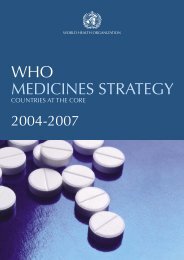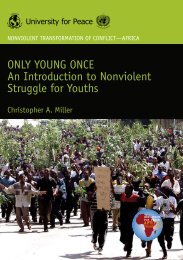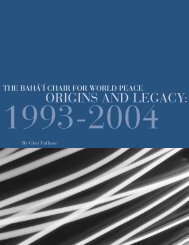environmental degradation as a cause of conflict in - Steiner Graphics
environmental degradation as a cause of conflict in - Steiner Graphics
environmental degradation as a cause of conflict in - Steiner Graphics
You also want an ePaper? Increase the reach of your titles
YUMPU automatically turns print PDFs into web optimized ePapers that Google loves.
IntroductionTHE Darfur Region lies <strong>in</strong> the northwestern part <strong>of</strong> the Sudan, neighbour<strong>in</strong>gLibya, Chad and the Central African Republic. The region <strong>in</strong>cludes the states<strong>of</strong> North, South and West Darfur. Each state is adm<strong>in</strong>istratively divided <strong>in</strong>toseveral localities amount<strong>in</strong>g to n<strong>in</strong>eteen <strong>in</strong> all three states. Each state is governedby a governor appo<strong>in</strong>ted by the president <strong>of</strong> the Sudan and <strong>as</strong>sisted by a number<strong>of</strong> state m<strong>in</strong>isters. Other state governmental structures <strong>in</strong>clude the judiciary andthe police. Mahaliy<strong>as</strong> are governed by commissioners (mutamad) appo<strong>in</strong>ted by thegovernor <strong>of</strong> the state and he is <strong>as</strong>sisted by a local council. The native adm<strong>in</strong>istrationwhich w<strong>as</strong> abolished <strong>in</strong> 1970 h<strong>as</strong> been recently revived.The population <strong>of</strong> Darfur which is largely rural (eighty percent) w<strong>as</strong> estimated<strong>in</strong> 1983 at about five million. However, there are <strong>in</strong>dications that the populationh<strong>as</strong> <strong>in</strong>cre<strong>as</strong>ed and with <strong>in</strong>cre<strong>as</strong><strong>in</strong>g mobility due to immigration from neighbour<strong>in</strong>gcountries and displaced people due to deteriorat<strong>in</strong>g economic conditions and <strong>in</strong>cre<strong>as</strong><strong>in</strong>gtribal <strong>conflict</strong>s. The populations are made <strong>of</strong> the same forty to fifty majortribes <strong>in</strong> addition to another fifty smaller groups. The tribes are identified <strong>as</strong> Arab,who are predom<strong>in</strong>antly p<strong>as</strong>toralists herd<strong>in</strong>g camels <strong>in</strong> the north and cattle <strong>in</strong> thesouth, and non–Arab groups (zurqa) who are largely sedentary cultivators <strong>of</strong> cropsand livestock, semi- nomads.Land <strong>in</strong> Darfur is divided <strong>in</strong>to tribal doma<strong>in</strong>s (hawakir) known <strong>as</strong> Dars, largely <strong>in</strong>the hands <strong>of</strong> the larger tribes, def<strong>in</strong>ed by customary law. This situation, togetherwith p<strong>as</strong>toralism, entail<strong>in</strong>g se<strong>as</strong>onal movements cross<strong>in</strong>g tribal Dars and farms <strong>of</strong>the sedentary population, h<strong>as</strong> resulted <strong>in</strong> <strong>conflict</strong>s over the p<strong>as</strong>ture resources andh<strong>as</strong> <strong>in</strong>tensified dur<strong>in</strong>g the l<strong>as</strong>t two decades and h<strong>as</strong> risen to national and <strong>in</strong>ternationaldimensions.The physical <strong>in</strong>fr<strong>as</strong>tructure <strong>in</strong>clud<strong>in</strong>g limited farm roads, railways and power supplyis generally poor, result<strong>in</strong>g <strong>in</strong> difficulties <strong>in</strong> travel, transport <strong>of</strong> goods andservices.The social services, <strong>in</strong>clud<strong>in</strong>g water supply, health and education are also generally<strong>in</strong>adequate together with shortage <strong>of</strong> and low capacity staff <strong>in</strong> health and educationsectors. The states are fac<strong>in</strong>g difficulties <strong>in</strong> undertak<strong>in</strong>g their responsibilities<strong>in</strong> law and order and development activities due to poor material and tra<strong>in</strong>edmanpower resources and the <strong>conflict</strong>.EcologyExtend<strong>in</strong>g from the north to the south, the climate <strong>of</strong> Darfur varies from the hotarid and semi-arid to the wet semi–tropic are<strong>as</strong> <strong>in</strong> the southern part. Ra<strong>in</strong>fall variesfrom zero <strong>in</strong> arid part and gradually <strong>in</strong>cre<strong>as</strong>es southwards reach<strong>in</strong>g 800mm annually86











